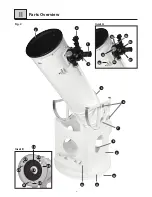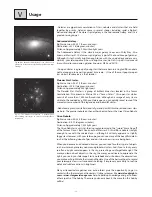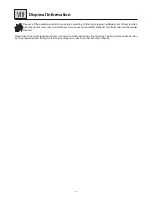
- 15 -
Maintenance and Cleaning
VI
Proper Care
Your telescope is a precision optical device and keeping the optics free of dust and dirt is
crucial for optimal performance. However, the use of improper cleaning techniques, tools
and/or solutions can cause irreparable damage to your telescope.
In terms of solutions, use distilled water and/or an optical glass cleaner that can be found at
most camera stores.
Only use pure cotton swabs/balls or white, unscented, lotion-free tissues for wiping down
optics after you have removed as many particles as possible with forced air or a photographic-
grade camel hair brush. DO NOT use optical lens cleaning tissues as many contain fiberglass
particles that can be abrasive.
Collimation
All telescopes are collimated precisely at the factory before shipment. However, a telescope
that was disassembled has to be freshly collimated after reassembly. Collimating a telescope
is a straightforward procedure that is not very difficult. The collimation procedure is slightly
different from that of other Newtonian reflecting telescopes, because of the "fast" f/5 to f/6
focal ratio of the primary mirror. In typical Newtonian reflectors with more conventional focal
ratios (i.e. longer focal ratios), when the observer looks down the focuser tube (without an
eyepiece in the focuser), the images of the diagonal mirror, primary mirror, focuser tube and
the observer's eye appear centered relative to each other.
However, with the short focal ratio primary mirror of this Dobsonian telescope, correct
collimation requires that the diagonal mirror be offset in 2 directions: (1) away from the
focuser and (2) towards the primary mirror, in equal amounts. This offset is approximately
1/8" in each direction. Note that these offsets have been performed at the factory prior to
shipment of your telescope. It is only necessary for you to confirm that the telescope has not
been badly jarred out of collimation, and to perform the final fine-tuning of Step 4, below. To
check and, if necessary, set the optical collimation, follow these steps:
1. Observe through the focuser and orient your body so that the telescope's primary mirror
is to your right, and the open end of the telescope tube is to your left. The diagonal mirror
will appear centered and round as shown (Fig. 24). If the diagonal appears off center, then
adjust the 3 collimation screws on the diagonal mirror housing.
2. If the reflection of the primary mirror (Fig. 24) is not centered on the surface of the diagonal
mirror, adjust the 3 collimation adjustment screws on the diagonal mirror housing to center
the reflection. As described above, the 3 collimation screws (Fig. 22, 2) on the diagonal
mirror housing are used for two different adjustments during the collimation procedure.
Fig. 21: Newtonian reflecting telescope. Spider vanes (1); secondary mirror (2); parabolic primary mirror (3); primary mirror adjustment screws (4); focuser drawtube (5); focused image (6).
Summary of Contents for Explore FirstLight 10" f/5 Dobsonian
Page 19: ...19...




























